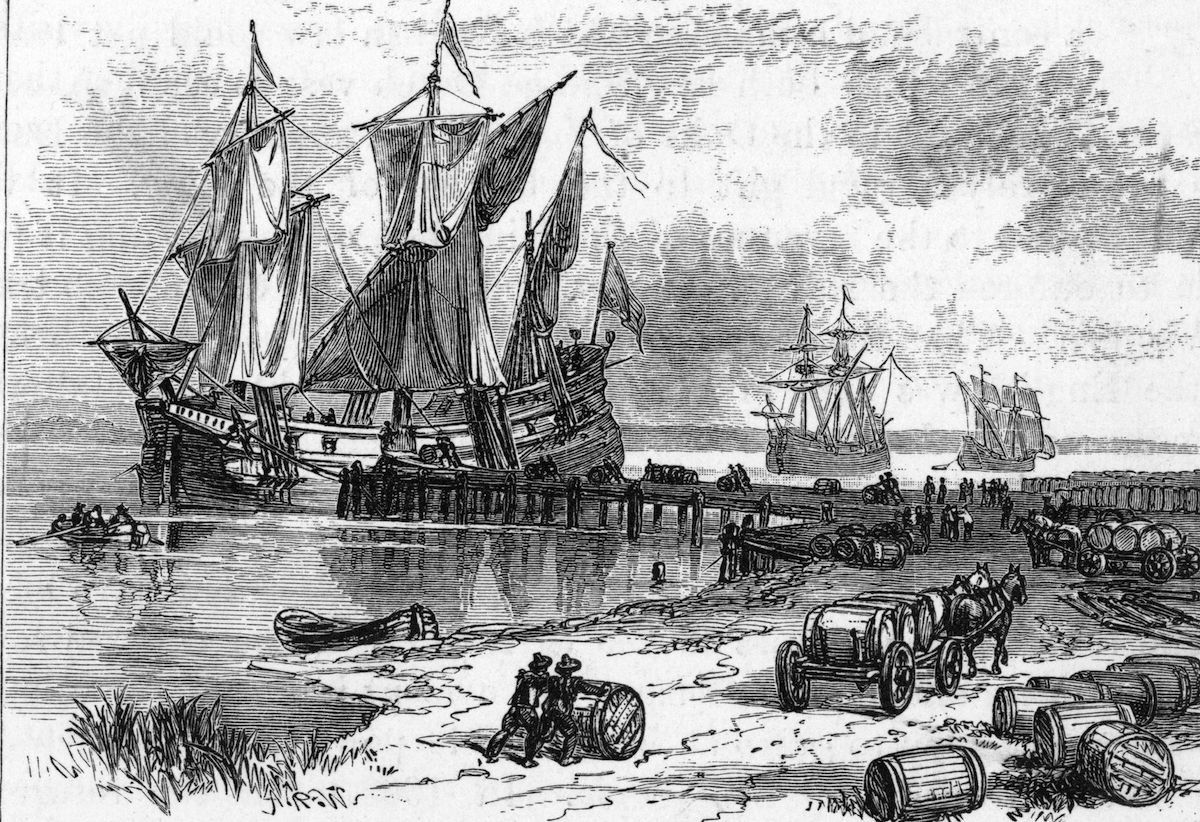
Money, or the lack thereof, was a persistent problem in colonial America. The colonists were under the control of Great Britain, where the legal tender was both gold and silver, known as a bimetallic system. Yet British coins circulated only rarely in the colonies. The colonists had an unfavorable balance of trade with the mother country, meaning that the value of the goods they imported from England greatly exceeded the value of the goods exported back. Most specie that flowed into the colonies through trade quickly flowed back to England in payment for these goods. Nor did the colonists have access to specie through any domestic gold or silver discoveries.
In order to have a functioning economy, the colonists were forced to turn to other commodities for use as money. Spanish coins, from trade with the West Indies and Mexico, circulated freely in the colonies as legal tender. While goods were officially valued in British pounds, in their day-to-day transactions colonists more commonly used the Spanish dollar as their unit of account. The Spanish coin known as “pieces of eight” was the most common coin in circulation throughout the colonies, but these were still too rare for the needs of the economy and were often exported as payment to England. From 1643 to 1660, wampum — the shells prized by local Native American tribes — were legal tender in Massachusetts. This promoted the development of the colony by facilitating trade, but the British did not approve of this monetary system and ended the practice in 1660. Throughout the seventeenth century, colonists further south in Virginia and North Carolina employed tobacco leaves as commodity money. In an effort to address the problem of durability, they later substituted tobacco warehouse receipts for the actual tobacco. These receipts were like promissory notes: they recorded the value of tobacco stored in warehouses for later sale. Since the bearer of the receipt had a claim on that exact amount of tobacco, the receipts circulated like currency. But tobacco receipts were not easily divisible, and the supply of both tobacco and wampum in circulation could fluctuate widely, making them inadequate stores of value.
Lacking a viable commodity to use as money, local colonial governments of the eighteenth century instead turned to paper money. Paper money could take one of two forms. Commodity-backed paper money was similar to the tobacco warehouse receipts. The value of the paper was directly equivalent to and convertible into a specific amount of some asset, such as gold or silver. But since the lack of gold and silver was precisely the problem in the colonies, colonists instead turned to the one asset they held in abundance: land. During the eighteenth century, several colonial governments created land offices whose purpose was to issue paper money backed by real estate. Colonists could take out loans using their land as collateral, receiving paper notes of the land office in return. These notes circulated in the local economy as currency. Borrowers could pay back their loans plus interest with the paper money or with harder-to-attain gold or silver. Failure to pay resulted in the foreclosure of their land, which could then be sold to pay off the loan. In the mid-Atlantic colonies of Pennsylvania, New York, New Jersey, Delaware, and Maryland, where land offices were most successful, the interest from these loans provided colonial governments with adequate funds for the day-to-day costs of government administration, lessening and sometimes even eliminating the necessity of taxation.
The other type of paper money is fiat money, meaning that its value is solely based on faith in the issuing party rather than on any concrete asset. During the eighteenth century, several colonial governments issued fiat money in payment for goods and services. This printing of fiat money was often in response to increased military expenses. Colonists were willing to accept this money partially because they had no other alternative, yet the government did promise to accept these same notes in payment for future taxes. The notes often circulated freely throughout the colony, easing the monetary problems of the region and facilitating trade, until they were retired (removed from circulation) at some set future point as they arrived back in the colonial treasury in payment for taxes or fees. Although British officials tried to ban this practice with the Currency Acts of 1751 and 1764, they only met with limited success.
The experience of the colonies with this fiat paper money varied widely. In those areas where money was limited in quantity to the amount of anticipated future tax receipts, fiat money tended to be successful. But some colonial legislatures acted irresponsibly, issuing fiat money well in excess of future receipts, printing new notes before earlier paper money issues had been collected and destroyed, and / or failing to include a specific date or means for retirement of the money. This resulted in price inflation and depreciation of the currency. As people lost faith in the future value of the money, they were less willing to accept it in payment for goods and services at face value, depressing the worth of the notes and making it a poor store of value.
This excerpt is taken from Other People’s Money: How Banking Worked in the Early American Republic by Sharon Ann Murphy. Published by Johns Hopkins University Press © 2017. Reprinted by permission of the publisher.
More Must-Reads From TIME
- The 100 Most Influential People of 2024
- The Revolution of Yulia Navalnaya
- 6 Compliments That Land Every Time
- What's the Deal With the Bitcoin Halving?
- If You're Dating Right Now , You're Brave: Column
- The AI That Could Heal a Divided Internet
- Fallout Is a Brilliant Model for the Future of Video Game Adaptations
- Want Weekly Recs on What to Watch, Read, and More? Sign Up for Worth Your Time
Contact us at letters@time.com